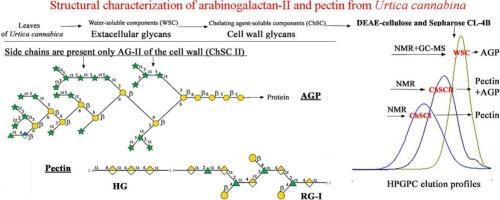大麻荨麻中阿拉伯半乳聚糖-II 和果胶的结构特征
IF 10.7
1区 化学
Q1 CHEMISTRY, APPLIED
引用次数: 0
摘要
研究人员采用化学方法、气相色谱、气相色谱-质谱、一维和二维核磁共振光谱,对荨麻叶细胞外和细胞壁聚糖进行了比较分析。细胞外 AG-II 和细胞壁 AG-II 的结构相似。其单元是典型的 AG-II:β-GlcpA-4-OMe-(1→,Rhap-(1→4)-β-GlcpA-(1→,在 O-6 端连接到 β-Galp,以及在 O-3 端连接到 β-Galp 的阿拉伯糖链。单个 Araf 和由 2,5-Araf 和两个末端 Araf 形成的三糖在 AG-II 中形成短阿拉伯呋喃侧链。仅在细胞壁 AG-II 的侧链中发现了在 O-3 端由单个 Araf 取代骨架的 1,5-阿拉伯糖。侧链可连接到同一 β-谷蛋白的 O-3 和 O-6 上,形成分叉的 AG 侧链。AG-II 的骨架是由 1,6- 而不是 1,3- 连接的 Galp 形成的,尽管其中也包括一些 1,3- Galp。3,6-Galp的高含量表明了AG碳水化合物链的高度支化性质。从细胞壁中提取 AGP 和果胶时,它们同时从 DEAE 纤维素和 Sepharose 中洗脱出来,这可能表明它们之间存在联系。本文章由计算机程序翻译,如有差异,请以英文原文为准。

Structural characterization of arabinogalactan-II and pectin from Urtica cannabina
Comparative analysis of extracellular and cell wall glycans from Urtica cannabina leaves was performed using chemical methods, GC, GC–MS, 1D, and 2D NMR spectroscopy. The structures of extracellular AG-II and cell wall AG-II are similar. The units are typical for AG-IIs: β-GlcpA-4-OMe-(1→, Rhap-(1 → 4)-β-GlcpA-(1→, attached to β-Galp at O-6, as well as arabinan chains attached to β-Galp at O-3. A single Araf and a trisaccharide formed by 2,5-Araf and two terminal Araf form short arabinan side chains in AG-II. 1,5-arabinan with a backbone substituted by a single Araf at O-3 was identified only in the side chains of cell wall AG-II. The side chains can be attached to O-3 and O-6 of the same β-Galp to form a bifurcated AG side chain. The backbone of AG-II is formed by 1,6- rather than 1,3-linked Galp, although it does include some 1,3-Galp. The high content of 3,6-Galp shows the highly branched nature of the AG carbohydrate chains. From the cell wall, AGP was extracted together with pectin, the simultaneous elution of which from both DEAE-cellulose and Sepharose may indicate a link between them.
求助全文
通过发布文献求助,成功后即可免费获取论文全文。
去求助
来源期刊

Carbohydrate Polymers
化学-高分子科学
CiteScore
22.40
自引率
8.00%
发文量
1286
审稿时长
47 days
期刊介绍:
Carbohydrate Polymers stands as a prominent journal in the glycoscience field, dedicated to exploring and harnessing the potential of polysaccharides with applications spanning bioenergy, bioplastics, biomaterials, biorefining, chemistry, drug delivery, food, health, nanotechnology, packaging, paper, pharmaceuticals, medicine, oil recovery, textiles, tissue engineering, wood, and various aspects of glycoscience.
The journal emphasizes the central role of well-characterized carbohydrate polymers, highlighting their significance as the primary focus rather than a peripheral topic. Each paper must prominently feature at least one named carbohydrate polymer, evident in both citation and title, with a commitment to innovative research that advances scientific knowledge.
 求助内容:
求助内容: 应助结果提醒方式:
应助结果提醒方式:


